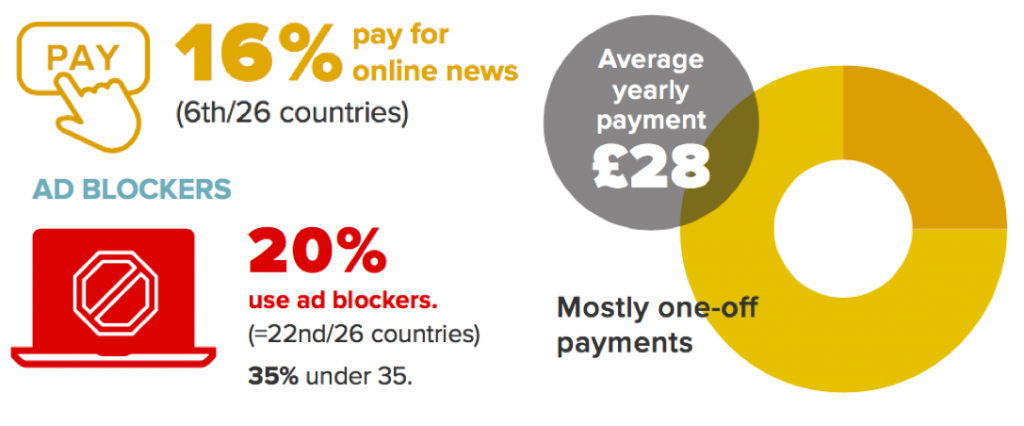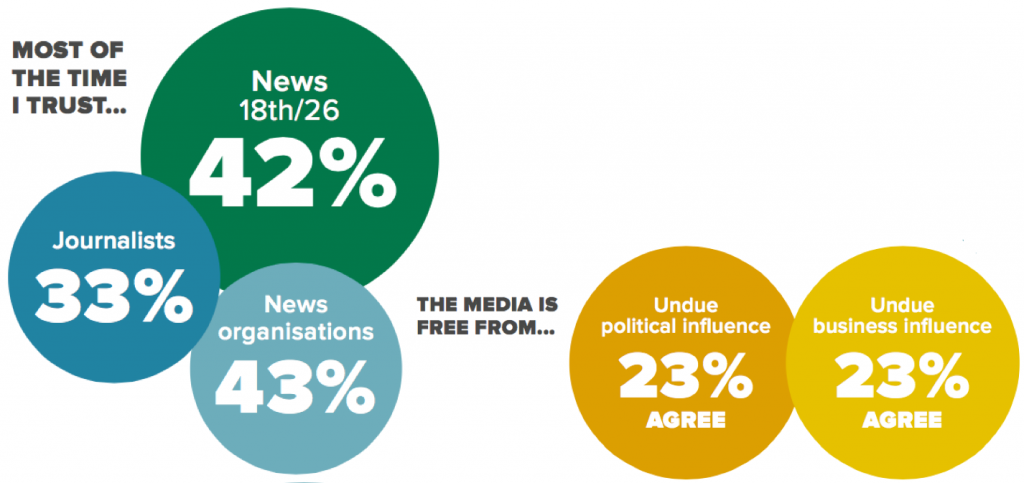| Statistics | |
| Population | 61m |
| Internet penetration | 62% |
The media environment is characterised by a strong television sector, a weak and declining print sector, and growing use of the internet and smartphones for news.
Top Brands % Weekly Usage (TV, Radio and Print)
| Weekly use | Main source | |
|---|---|---|
| RAI news (Tg1, Tg2, Tg3, TgR) | 64% | 23% |
| Mediaset news (Tg4, Tg5, Studio Aperto) | 53% | 19% |
| SkyTg24 | 36% | 11% |
| RaiNews24 | 36% | 6% |
| Tg La7 | 32% | 6% |
| TgCom24 | 30% | 5% |
| La Repubblica | 30% | 4% |
| Ballarò | 29% | 1% |
| Il Corriere della Sera | 25% | 3% |
| Porta a Porta | 21% | 0% |
| Quinta colonna | 21% | 2% |
| La Stampa | 21% | 4% |
| Il Sole 24 Ore | 18% | 1% |
| Commercial radio news | 18% | 2% |
| Piazza pulita | 17% | 0% |
| A regional or local newspaper | 17% | 1% |
Top Brands % Weekly Usage (Online)
| Weekly use | Main source | |
|---|---|---|
| La Repubblica online | 33% | 11% |
| TgCom24 online | 28% | 10% |
| Sky Tg24 online | 23% | 7% |
| Ansa online | 23% | 8% |
| Il Corriere della Serra online | 21% | 4% |
| Yahoo News | 21% | 6% |
| Il Fatto Quotidiano online | 18% | 5% |
| Notizie.Libero.it | 17% | 4% |
| La Stampa online | 16% | 6% |
| Il Sole 24 ore online | 16% | 2% |
| MSN News | 16% | 4% |
| RAI News online | 15% | 4% |
| Tg La7 online | 13% | 2% |
| Huffington Post | 12% | 1% |
| Il Giornale | 11% | 2% |
| Regional or local newspaper website | 11% | 3% |
Overview of key developments
By Alessio Cornia
Research Fellow, Reuters Institute for the Study of Journalism
Television viewing in Italy ranks among the highest in Europe and TV news bulletins remain the main source of information, not least because overall internet penetration is much lower than other developed countries. 1 In March 2016,La Repubblica and La Stampa, the latter owned by car-maker Fiat Chrysler, announced plans for a merger that will lead to the creation of Italy’s biggest publishing group.
The income of Italian traditional media (newspapers, TV, and radio) is declining significantly (-12% between 2010 and 2014), with print more dramatically affected (-30%). 2 Revenues within the online sector are growing, but they still represent a minor share of overall media company revenues.
In terms of online news, most business models are based on advertising although there have been some experiments with paid content. In January 2016, leading Italian newspaper Il Corriere della Sera adopted a metered paywall for its online news. Other newspapers, such as La Stampa and the business news outlet Il Sole 24 Ore, have also introduced forms of premium content for specialised news and databases.
According to the 2015 AGCOM report, the contribution of the newspapers’ digital activities to their overall revenue is up from 5% in 2010 to 10% in 2014, but this growth far from offsets losses from traditional print operations.
Legacy news organisations still dominate usage online. Indeed, the websites with the widest reach are those of the main Italian newspapers La Repubblica.it, Il Corriere.it, Il Fatto Quotidiano.it,
La Stampa.it and Il Sole 24 Ore.it, the main private TV operators (the Mediaset’s TgCom24.it and SkyTg24), and the main news agency (ANSA). The public broadcaster RAI has not yet completed the transition from a broadcasting to a multichannel media company: while its TV newscasts (Tg1, Tg2, and Tg3) have the widest offline reach, its online platforms (Rainews.it and RAI.it) are marked by below par performances.
Digital-born players, such as Huffington Post Italia (12%), Fanpage (9%), and Il Post (5%), have increased their reach, but audiences are not comparable to the legacy players. Our data show that many Italians also like to use news aggregators, such as Google News (19%) and Giornali (17%) (a news app for Android devices).
Changes in media usage 2013–2016
Television news remains the most important source of news in Italy, particularly as Italy has one of the lowest internet penetration rates in Europe. Amongst online users, social media has grown rapidly as a source of news.
WEEKLY REACH PER DEVICE
| Computer | Smartphone | Tablet | |
|---|---|---|---|
| 2013 | 59% | 26% | 14% |
| 2014 | 74% | 36% | 18% |
| 2015 | 65% | 44% | 19% |
| 2016 | 62% | 53% | 22% |
SOURCE OF NEWS 2013–16
| TV | Online (inc. social) | Social | ||
|---|---|---|---|---|
| 2013 | 74% | 59% | 80% | 27% |
| 2014 | 76% | 51% | 80% | 36% |
| 2015 | 78% | 43% | 81% | 46% |
| 2016 | 83% | 43% | 83% | 54% |
Paying for news
The relatively high headline rate (16%) masks the fact that just 4% have ongoing digital news subscriptions, with most of those that pay doing so through one-off purchases of single editions.
Trust
The partisanship of Italian journalism combined with political and business influence on media organisations has led to relatively low levels of trust in the news. Trust in journalists is particularly low perhaps because the most-popular Italian journalists tend to clearly express their political positions within their analysis or during their participation, as guests, in talk shows.
Scroll data area to see more
TOP SOCIAL NETWORKS*
| RANK | NETWORK | ALL | U35s |
|---|---|---|---|
| 1 | 54% | 62% | |
| 2 | YouTube | 23% | 23% |
| 3 | 20% | 22% | |
| 4 | 10% | 12% | |
| 5 | 5% | 9% |
- EAO 2015; http://www.demos.it/a01201.php
Although new channels have been created in recent years, the Italian television sector remains highly concentrated. Almost 90% of the overall revenues are generated by just three companies: the pay-TV Sky Italia, the private group Mediaset, and the public broadcaster RAI. A fourth operator, La7, has invested strongly in its news output, but remains marginal in terms of both revenue and audience share. [26. AGCOM 2015 https://www.agcom.it/annual-report
The RAI-Mediaset duopoly, which is slowly weakening, has always raised concerns about pluralism of information in a country marked by strong TV viewership. In addition, the two main operators are heavily shaped by politics. The owner of Mediaset, Silvio Berlusconi, is still leader of one of the main Italian political parties, while RAI programming has long been subject to political influence. It is too early to assess whether a reform of RAI’s governance, approved in December 2015, will strengthen its independence.
Newspaper readership has always been low in Italy and the newspaper landscape consists of commercially weak dailies addressing an elite and politically defined audience. Consequently the agenda of the press is often influenced by business and political interests – with many Italian papers providing a partisan view on political, economic, and social developments.
The press sector is less concentrated than TV. Two main publishers, RCS (that publishes Il Corriere della Sera) and Gruppo Espresso (that publishes centre-left La Repubblica) together account for 40% of the sector revenues. [27. AGCOM 2015. ↩
- AGCOM 2015. ↩


